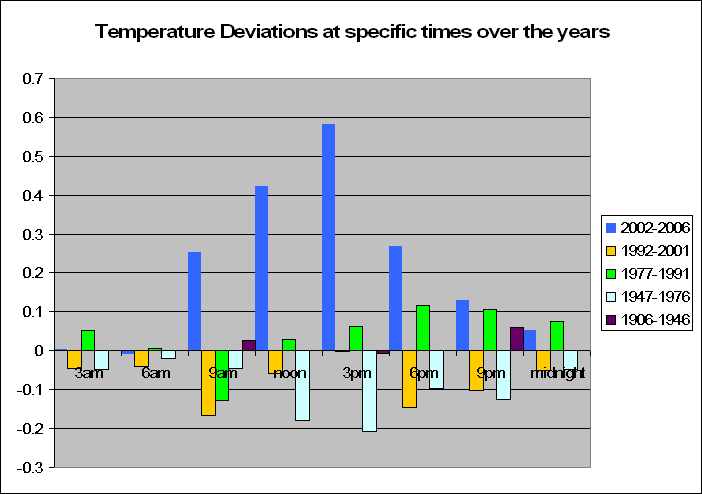So what is happening in these last few years of increase in maximum temperatures? It is strange that research has not decided to look into this, and has generally just accepted the fact that we are warming up.

The graph to the left shows the deviations from the norm at certain times of the day with reference to last 5 years, 15, 30, 60 and 100 years. Data for the last 100 years was only available for 9am, 3pm and 9pm.
Lets look at the last 5 years to start off with. At the heat of the day, at around 3pm, we see that temperatures in the last 5 years have increased by on average almost 0.6 degrees. But interestingly, at other times of the day, the decrease is less. In fact at 3am and 6am, when the sun does not shine, there is no increase at all in temperature. As the earth spins further away from the sun, the temperature deviation from the norm decreases. Between 1992 and 2001 we had less than normal temperatures with the exception of 3pm. The previous 15 years before that showed an increase in temperatures at around the 6pm to 9pm mark, and from 1947 to 1976, where it is well known that maximum temperatures were on the decrease, this graph shows this. With temperatures at what would normally be at the peak, 3pm, being around 0.2 degrees below the norm. Interestingly here, that when the sun is on the other side of the world, the temperature difference is minimal.
So why is it that in most recent times, we are heating up during the heat of the day and not at other times? Admittedly it is only a small sample size of 5 years, but it might well be worth some debate. This data clearly proves, that Australia is not uniformly heating up at all times, but only when the sun is at its peak. Hence the reason why we get increased maximum temperatures more recently.
It is interesting, that the increased maximum temperatures of late only occur because of an increasing temperature around 3pm (the heat of the day) and not at other times. Likewise the decreased maximum temperature from around 1947 to 1976 only occurred because of a decrease in temperatures around 3pm (the heat of the day) and largely not at other times.
If CO2 were the primary causer of increased temperatures in Australia, then wouldn’t we get a more consistent temperature increase throughout the day and night? Analysis at certain times of the year, and when there is/isn’t cloud cover might well be the key here.
Keep in mind however, that the increase in temperature over the past 5 years is not significant, but is still worth a look into, as it seems this is rarely done in the literature.
9 comments:
Hi, nice study! Sun could be a factor of some kind here, but the best explanation to the phenomena you've noticed might be clearing of air? Especially because 5 years is so short time period that sun itself probably doesn't have time to have its effect on temperatures? I don't know what the pollution levels have been before in Australia but if your air quality has increased this is just the phenomena one would observe.
In general, I don't see CO2 as a factor in global warming. It's all result of sun and cleaner air.
"If CO2 were the primary causer of increased temperatures in Australia, then wouldn’t we get a more consistent temperature increase throughout the day and night? Analysis at certain times of the year, and when there is/isn’t cloud cover might well be the key here."
No, you can't see the effects of CO_2 by only looking at a few year's time interval. The Earth has only warmed up by 0.6 °C in the last century.
The fact that 0.3 °C temperature fluctuations seem to correlate well with sunshine has no relevance whatsoever to climate change.
agreed count iblis two, that you can't see the effects of CO2 by only looking at a few years, but what about my analysis of the past 100-150 years?
Hi Jonathan,
The rate at which Australia is heating (or cooling) is constrained by the confidence interval for the rate that you have obtained.
That seems to me the most reasonable thing you could say...
This analysis is actually better than suggested. If both the oldest and the most recent measurement windows would be combined then the result would be the same - but statistically more significant. Yes, clearer air or human generated/induced (i.e. forest clearings) heath during daytime or could be an answer, but so is the sun. It would be extremely interesting to see the same analysis for different global regions.
"It would be extremely interesting to see the same analysis for different global regions."
That's the plan
So how does this tie up with the plots in the 'barmy nights' post?
You start that post with "Whilst there is insufficient evidence to prove that we are warming up during the day, there is good evidence to prove that our nights are getting warmer."
Yet this post seems to indicate that night-time temperatures are relatively stable and daytime temperatures are on the rise. Am I missing something? It's entirely possible, I've not long found this blog and have had a long hot day.
I have looked at maximum temperatures a lot and will start to look at minimum temperatures in the next couple of posts.
This is grreat
Post a Comment